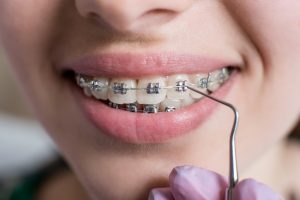Blog
Choosing The Better Option For You: Invisalign Vs. Braces

Braces or Invisalign? It’s the ultimate smile showdown, folks! In one corner, we have the classic heavyweight champion, braces, with their undeniable charm and jaw-dropping transformations. And in the other corner, we have the sleek and discreet contender, Invisalign, ready to knock out misaligned teeth without anyone even noticing.
Get ready for a dental battle royale as we compare these two smile-transforming contenders and help you decide which one will reign supreme for your oral needs. Let’s get ready to rumble for that picture-perfect grin!What Is Invisalign?
Invisalign is a revolutionary orthodontic treatment that utilizes a series of custom-made, clear aligners to gradually straighten teeth. It offers an alternative to traditional braces for individuals seeking a discreet and comfortable way to achieve a beautiful smile.
The Invisalign process begins with a comprehensive examination by a trained orthodontist or dentist. Using advanced 3D imaging technology, they will create a personalized treatment plan tailored to your specific dental needs. This plan will outline the precise movements your teeth will undergo throughout the treatment.What are the benefits of Invisalign?
- Time-Saving Convenience: Invisalign treatment typically requires fewer visits to the orthodontist compared to traditional braces. The aligners are provided in sets, and you will receive several sets at a time, reducing the frequency of office visits for adjustments.
- Dental Protection: Invisalign aligners provide a layer of protection for your teeth. They act as a shield, minimizing the risk of damage or wear from teeth grinding or clenching, especially for individuals who have a habit of bruxism.
- Versatility for Active Lifestyles: Invisalign is an excellent choice for individuals with active lifestyles or those involved in contact sports. The aligners can be temporarily removed during sports activities, allowing you to wear a protective mouthguard without interference.
- Gradual Teeth Straightening: Invisalign aligners apply gentle, controlled forces to gradually shift your teeth into their desired positions. This reduces discomfort during treatment compared to the periodic adjustments required with braces.
- Improved Confidence: Achieving a straighter smile with Invisalign can significantly boost self-confidence and improve overall dental aesthetics. The discreet nature of Invisalign allows you to go about your daily life with confidence, knowing that your orthodontic treatment is hardly noticeable.
It’s important to note that while Invisalign is suitable for many cases, not all dental concerns may be effectively addressed with this treatment option. Consulting with an experienced orthodontist or dentist will help determine if Invisalign is the right choice for you based on your specific dental needs and goals.
What Are Braces?
Braces are orthodontic appliances designed to correct various dental misalignments and improve oral health. They consist of metal brackets and wires that work together to exert gentle pressure on the teeth, gradually moving them into their desired positions. By applying controlled forces, braces effectively address common issues such as crowded teeth, gaps, overbites, underbites, and crossbites.
The process begins with an initial consultation where an orthodontist assesses the patient’s dental condition and develops a customized treatment plan. The braces are then carefully attached to the teeth using special dental adhesive. The archwires, which connect the brackets, are adjusted periodically to guide the teeth into proper alignment.
What are the benefits of wearing braces?
Braces offer a range of benefits in correcting dental misalignments and improving oral health. Here are some key advantages of braces:
Teeth Alignment: Braces effectively straighten crooked or misaligned teeth, enhancing both the aesthetic appearance and functionality of the smile.
- Bite Correction: Braces can address bite issues such as overbites, underbites, crossbites, and open bites, improving the overall alignment of the jaws and teeth.
- Improved Oral Health: Properly aligned teeth are easier to clean, reducing the risk of tooth decay, gum disease, and other oral health problems. Braces help align the teeth for better oral hygiene.
- Enhanced Chewing and Speech: Correcting misaligned teeth with braces can improve chewing efficiency and speech clarity, leading to better overall oral function.
What To Choose Between Invisalign And Braces?
When choosing between Invisalign and braces, several factors come into play:
Aesthetics: Invisalign offers a more discreet appearance, while braces are more noticeable due to metal brackets and wires.
- Treatment Complexity: Braces are typically better for complex cases, while Invisalign is suitable for mild to moderate issues.
- Oral Hygiene: Invisalign aligners are removable, allowing for easier cleaning, while braces require extra care around brackets and wires.
- Dietary Restrictions: With braces, certain foods should be avoided to prevent damage, while Invisalign has no dietary restrictions.
- Comfort: Invisalign aligners tend to be more comfortable, while braces may cause some discomfort or irritation.
- Treatment Duration: Braces may achieve results faster in some cases compared to Invisalign.
- Compliance: Invisalign requires consistent wear, while braces are fixed and don’t require removal.
- Age Considerations: Invisalign is popular among adults, while braces are commonly used in children and teenagers.
Consulting with a dental professional will help determine the best option for your specific needs and goals. Visit Coburg Dental Group now!






